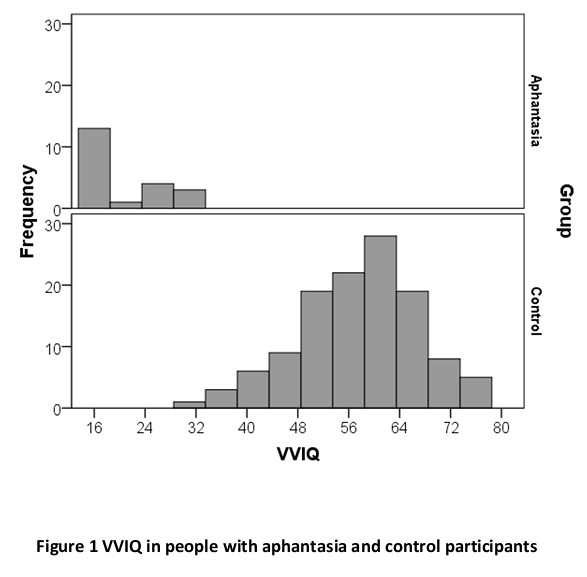Lives without imagery – congenital aphantasia
Lives without imagery – congenital aphantasia
by Adam Zeman, Michaela Dewar, and Sergio Della Sala
Cortex, Available online 3 June 2015,
doi:10.1016/j.cortex.2015.05.019
1. Introduction
Visual imagery is, for most of us, a conspicuous ingredient of everyday experience, playing a prominent role in memory, daydreaming and creativity. Galton, who pioneered the quantitative study of visual imagery with his famous ‘breakfast-table survey’, reported a wide variation in its subjective vividness (Galton, 1880). Indeed, some participants described ‘no power of visualising’. This phenomenon has received little attention since, though Faw reported that 2.1-2.7% of 2,500 participants ‘claim no visual imagination’ (Faw, 2009).
The experience of voluntary imagery is associated with activity in fronto-parietal ‘executive’ systems and in posterior brain regions which together enable us to generate images on the basis of our stored knowledge of appearances (Bartolomeo, 2008). The relative contributions of lower and higher order visual regions to the experience of visual imagery are debated (Bartolomeo, 2008). Clinical reports suggest the existence of two major types of neurogenic visual imagery impairment: i) visual memory disorders, causing both visual agnosia and imagery loss, and ii) ‘imagery generation’ deficits selectively disabling imagery (Farah, 1984).
In 2010 we reported a particularly ‘pure’ case of imagery generation disorder, in a 65 year old man who became unable to summon images to the mind’s eye after coronary angioplasty (Zeman et al., 2010). Following a popular description of our paper (Zimmer, 2010), we were contacted by over twenty individuals who recognised themselves in the article’s account of ‘blind imagination’, with the important difference that their imagery impairment had been lifelong. Here we describe the features of their condition, elicited by a questionnaire, and suggest a name – aphantasia - for this poorly recognised phenomenon.
2. Results
21 individuals contacted us because of their lifelong reduction of visual imagery. We explored the features of their condition with a questionnaire devised for the purpose and the Vividness of Visual Imagery Questionnaire (VVIQ) (Marks, 1973) (see supplementary material for further details). Participants typically became aware of their condition in their teens or twenties when, through conversation or reading, they realised that most people who ‘saw things in the mind’s eye’, unlike our participants, enjoyed a quasi-visual experience. 19/21 were male. 5/21 reported affected relatives. 10/21 told us that all modalities of imagery were affected. Our participants rating of imagery vividness was significantly lower than that of 121 controls (p<.001 mann whitney u test see figure despite their substantial or complete deficit in voluntary visual imagery as judged by the vviq majority of participants described involuntary imagery. this could occur during wakefulness usually form and dreams within a group who reported no while completing confirming significant dissociation between mcnemar varied but modest effect on mood relationships. difficulties with autobiographical memory. same number identified compensatory strengths verbal mathematical logical domains. successful performance task that would normally elicit how many windows there are your house apartment achieved drawing what models.>
3. Discussion
φαντασία, phantasia, is the classical Greek term for imagination, defined by Aristotle as the ‘faculty/power by which a phantasma [image or mental representation] is presented to us’ (Aristotle, 1968). We propose the use of the term ‘aphantasia’ to refer to a condition of reduced or absent voluntary imagery. Terms used previously in related contexts include ‘defective revisualisation’ (Botez, Olivier, Vezina, Botez, & Kaufman, 1985) and ‘visual irreminiscence’ (Nielsen, 1946).
Sceptics could claim that aphantasia is itself a mere fantasy: describing our inner lives is difficult and undoubtedly liable to error (Hurlburt & Schwitzgebel, 2007). We suspect, however, that aphantasia will prove to be a variant of neuropsychological functioning akin to synaesthesia (Barnett & Newell, 2008) and to congenital prosopagnosia (Gruter, Gruter, Bell, & Carbon, 2009). Indeed, aphantasia may have some specific relationship to these disorders, as congenital prosopagnosia is associated with unusually low (Gruter et al., 2009), and synaesthesia with unusually high (Barnett & Newell, 2008), VVIQ scores.
The participants described here were self-selected and some of our findings, such as the male predominance, may reflect the readership of a science magazine like Discover. There is a need, therefore, for further study in a more representative sample. The existence of lifelong ‘aphantasia’ raises numerous additional questions. How commonly does congenital aphantasia occur? Existing data suggest a frequency of around 2% but there is no fully reported large scale study. The evidence of familial occurrence should be investigated further. Does congenital aphantasia have objective neuropsychological associations? Correlations between imagery vividness and cognitive functioning have been elusive in the past, but recently developed measures of autobiographical memory (Levine, Svoboda, Hay, Winocur, & Moscovitch, 2002), imaginative thinking and ‘visual-object intelligence’ (Blazhenkova & Kozhevnikov, 2010) open up new avenues for exploration. Personality and mood may also be relevant variables. Are there subtypes of congenital aphantasia? The descriptions given by our participants suggest that in some cases visual memory is preserved even if visual imagery is absent, while others may rely entirely on non-visual representations in memory tasks; the relationship between aphantasia and congenital prosopagnosia also deserves further study. If, as we hypothesise, the absence or reduction of visual imagery has neural correlates, can we discover these? We are optimistic that modern structural and functional brain imaging may help to answer questions about the nature of visual imagery that were first posed in ancient Greece and first quantified at Sir Francis Galton’s breakfast table over a hundred years ago.
[continue]

